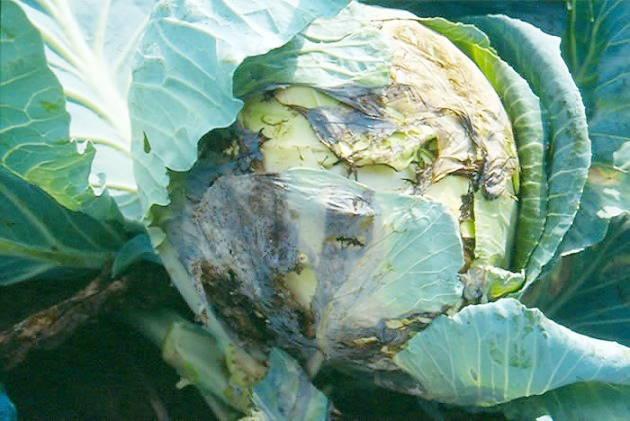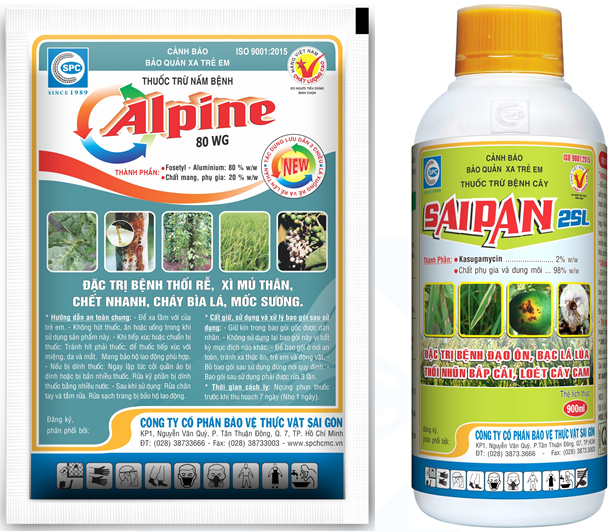|
Cabbage Soft Rot Disease
10/11/2021
Ph.D Nguyen Minh Tuyen Cabbage is one of the vegetables that are loved by the market and consumed all year round, in large quantities. Therefore, growing cabbage often gives high economic income. However, pests and diseases are one of the factors that increase costs and hinder production. One of the dangerous diseases, which has caused significant losses to cabbage production, is soft rot disease. * Symptoms and effects: The disease usually arises when the cabbage was rolled, the plant has fully bloomed on the ground. The disease usually appears on the plant close to the base or the old leaves close to the damp soil, then spreads inward and upward. The lesions are usually watery, dark brown in color and have a very foul odor. Once infiltrated, they cause the stem to rot and slide out of the cabbage easily. When the garden has high humidity, the disease can also attack directly on the outer leaves of the cabbage, then spread inward, causing the whole cabbage to rot. After harvesting, during transportation or storage, the disease continues to spread to other cabbages, reducing the commercial value.
* Pathogens and conditions of development: Cabbage soft rot is caused by Erwinia sp. In conditions of high density planting, excessive nitrogen fertilization, plants are too green, dense leaves, combined with gardens often watering in the style of rain spray, gardens are too low humidity ... the disease is often severe. The disease also often occurs when the weather is rainy, hot and humid, and the garden has a high density of pests. * Highly effective preventive measures: The principle is to apply a combination of many possible measures. - Plant vegetables with appropriate density to ensure ventilation, less rubbing together. - Raise the bed high enough to help the garden open and dry. - Limit watering in the form of rain spray with great pressure, so irrigation should be in the trench. - Preventing pests to limit causing mechanical wounds and penetrating diseases. - Prune the old leaves to allow the root to be ventilated. - When taking care, limit rubbing vegetable crops. - Use CALCIUM NITRATE to help increase disease resistance. - Fertilize with adequate balance, not excess nitrogen, avoid dense and soft plants. - Use fertilizer TANO-601 to provide necessary micronutrients to increase resistance. - In the period of heavy rain and wind, it is necessary to check to detect diseases for timely prevention, or proactively spray to prevent diseases, which will help reduce damage and reduce prevention costs. - When detecting early disease in the vegetable garden, it should be prevented with one of the less toxic biological products such as SAIPAN 2SL, or ALPINE 80WG.
|
To prevent, in addition to plowing and burying weed seeds, collecting weed stalks and stumps left after tilling the land to burn, not letting weeds produce seeds in production fields, etc., the use of chemical products is still a measure. optimal because of its ability to thoroughly kill weeds, reduce labor and take advantage of more time than manual weeding.
Miner has the scientific name Phyllocnistis citrella Staint., family Phyllocnistidae, order Lepidoptera. The miner occurs in many countries in the tropics and subtropics. The main host of the miner is the citrus family - Rutaceae. In addition, the miner also attacks mangosteen and some other plants.
Adult is a small planthopper, with a body 2-3 mm long, the whole body is ash gray, slightly greenish, the wings are opaque with many small brown spots.Eggs are oval, 0.3 mm long, have a pointed end and are attached directly to the leaf surface, leaf axils.
Green bugs specialize in the fruit of citrus groups (oranges, tangerines, lemons, grapefruits, kumquats...), some people call them orange bugs, or orange suckers. Their scientific name is Rhynchocoris poseidon or Rhynchocoris humeralis.
In Vietnam, yellow leaf curl disease is very common on papaya trees, especially the disease is often severe in areas of high and continuous planting, areas with hot and arid climates. The disease has significantly reduced the yield and quality of papaya. Gardens that are infected early when the plants are young may not yield. However, up to now, many gardeners still do not know the cause and how to fix it.
Spider mites are common pests on citrus trees, especially in hot and dry climates that are suitable for spiders to grow and cause severe damage.The group of harmful spiders is usually very small in size, unlike the natural enemy spiders.
This group includes species that are generally very small in size, causing damage by sucking plant sap (on leaves, fruits, branches, stems).
There are many species of mealybugs present on the group of Oranges,Tangerines,Grapefruits and Lemons (Citrus), which can be divided into 2 groups:
+ Group of sticky mealybugs with common varieties such as Lepidosaphes, Aonidiella, Coccus and Saissetia.
+ Group of flower mealybugs with common genera and species such as Pseudococcus, Planococcus and Icerya purchasi.
Dry branches and berries disease often appear to be common damage on coffee gardens during the rainy season. The disease causes death of branchs, dry fruit, severely affects the canopy structure and coffee yield if not paid attention to prevention.
Pink disease commonly causes diseases on rubber plantations in the rainy season, especially on garden from 4-8 years old. This year, rubber has to go through a period of severe drought, weakening the tree, so now in tnshe rainy season it is easy to get infected. Therefore, it is necessary to pay attention to good management to avoid affecting the garden.
In recent years, the area of citrus has been expanded because it is a fruit tree with high economic efficiency. However, in order to sell at a high price, not only in quality but consumers also require the external beauty of the fruit, so pest management on citrus is a matter of great concern to farmers. The hot season is a favorable condition for thrips to develop and cause damage, affecting the commercial value of fruit.
- Headquarters
- SAIGON PLANT PROTECTION JOINT STOCK COMPANY
- RQ 1, Nguyen Van Quy St., Tan Thuan Ward, HCM City
- Tax code: 0300632232
- Tel: (028) 38 733 295 - 38 732 077
- Fax: (028) 38 733 003 - 38 733 391
- Website: www.spchcmc.vn - Email: info@spchcmc.vn
- SAIGON PLANT PROTECTION COMPANY
- SAIGON PLANT PROTECTION JOINT STOCK ENTERPRISE
- Lot C1-C3 Hiep Phuoc Industrial Park, Hiep Phuoc Commune, HCM City
- Tel: (028) 3873 4089 - Fax: (028) 3873 4086
- Affiliated Unit
-
- Quick Links
- Home
- About us
- Career Opportunities













